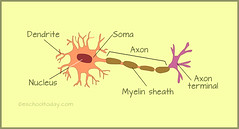![]()
![]()
![]()
Use LEFT and RIGHT arrow keys to navigate between flashcards;
Use UP and DOWN arrow keys to flip the card;
H to show hint;
A reads text to speech;
36 Cards in this Set
- Front
- Back
|
Biological Psychology |
a branch of psychology concerned with the links between biology and behavior |
|

Neuron |
a nerve cell, a basic building block of the nervous system |
|

Dendrites |
receives messages and conduct them toward the cell body |
|
|
Axon |
sends messages to other neurons or cells |
|
|
Action Potential |
a nerve impulse |
|
|
Glial Cells |
cells in the nervous system that support, nourish, and protect neurons. also play a role in learning, thinking and memory |
|
|
Synapse |
a junction between two nerve cells, consisting of a minute gap across which impulses pass by diffusion of a neurotransmitter.
|
|
|
Threshold |
level of stimulation required to trigger a neural impulse |
|
|
All or None Response |
a neurons reaction of either firing or not firing |
|
|
Neurotransmitters |
neuron produced chemicals that cross synapse to carry messages to other neurons or cells |
|
|
Serotonin |
affect mood, hunger, sleep and arousal |
|
|
Dopamine |
influences movement, learning, attention, and emotion |
|
|
Acetylcholine |
enables muscles actions, learning and memories |
|
|
Norepinephrine |
helps control alertness and arousal |
|
|
Gamma-aminobutyric acid |
a major inhibitory neurotransmitter |
|
|
Glutamate |
a major excitatory neurotransmitter: involved in memory |
|
|
Endorpins |
influences the perception of pain and plessure |
|
|
Opiate |
a chemical that depresses neural activity, temporarily lessening pain and anxiety |
|
|
Nervous System |
the body's speedy, electrochemical communication network. consisting central and peripheral nervous system |
|
|
Central Nervous System |
the brain and the spinal cord |
|
|
Peripheral Nervous System |
the sensory and motor neurons connecting the central nervous system to the rest of the body. |
|
|
Nerves |
a electoral cables formed of bundles of axon |
|
|
Sensory Neurons |
carries incoming information from the receptors to the central nerves system |
|
|
Motor Neurons |
carries outgoing information from the central nervous system to the muscles and glands |
|
|
Interneuron |
within your brain and spinal cord communicate with one another and process information between the sensory input and motor output |
|
|
Somatic Nervous System |
monitors sensory input and triggers motor output controlling you skeletal system |
|
|
Automatic Nerves System |
controls self-regulated actions of internal organs and glands |
|
|
Sympathetic Nervous System |
mobilizing its energy in stressful situations |
|
|
Parasympathetic |
clams the body, conserving its energy |
|
|
Reflex |
a simple, automatic response |
|
|
Endorcine |
the bodies slow chemical communication |
|
|
Adrenal Gland |
to help arouse the body in times of stress |
|
|
Pituitary Gland |
regulates growth and controls other endocrine glands |
|
|
Hormones |
a form of chemical messenger, which travels through bloodstream and influence behaviors and emotions |
|
|
Brianstream |
oldest part. begins where the spinal cord swells and enters the skulls; responsible for automatic survival functions |
|
|
Medulla |
controls heartbeat and breathing |

